Possible reasons why anthurium leaves turn yellow and methods of control
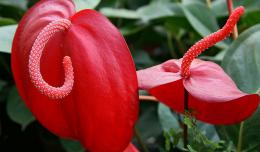
Anthurium is an ornamental foliage plant with beautiful red, pink or white flowers. This plant is popular among gardeners and does not require special attention. It can be grown at homeHowever, the necessary conditions must be provided for this. Quite often, gardeners are faced with the problem of yellowing anthurium leaves. Why is this happening and what to do?
Content:
- Description of the plant
- Features of caring for anthurium
- How to grow anthurium
- Possible problems during cultivation
Description of the plant
Anthurium is an epiphytic plant of the Araceae family. The leaves of the plant are medium-sized leathery, can be whole or dissected, plain or with a pattern, depending on the plant variety. There are a large number of types of anthurium, which differ in their appearance, varied leaf shapes and a wide range of colors:
- Baker's Anthurium
- Anthurium majestic
- Anthurium climbing
- Anthurium Hooker
- Anthurium crystal
- Anthurium Scherzer
The plant can reach 0.8-1 meters in height. The stem is shortened and has numerous roots. The leaves can reach 40 cm in length and 15-20 cm in width. The inflorescence is in the form of a cob and can have a cone-shaped, spherical, club-shaped structure. The cob can be white or yellow, and the color of the leathery spathe can be from white to dark purple.The plant can bloom all year round in normal light.
Features of caring for anthurium
The anthurium pot should be placed on the east or west side of the window. In such a place the plant will have enough diffused light. You can place the pot on the south side, but if direct sunlight hits the leaves, it is recommended to cover the glass.
For normal plant development, the room temperature should be between 22-28 degrees. It should be remembered that drafts and temperature changes anthurium can't stand it. During the growing season, watering is carried out abundantly.
Watering should be done with settled and soft water. It is important not to over-moisten the substrate, as the roots may begin to rot. If there is any water left in the pan, it should be drained immediately. Anthurium needs high humidity, so you should periodically spray the plant and wipe the leaves with a damp sponge. When spraying, you must ensure that water does not get on the flowers, otherwise they will wither.

Anthurium should not be forgotten to feed. It is recommended to apply fertilizers in spring and summer, every 20 days. Mineral fertilizer must be diluted with water. The plant tolerates foliar feeding well. In the autumn, it is useful to feed with organic fertilizers - bird droppings or leaf humus, rotted manure.
How to grow anthurium
After purchase, it is recommended to transplant the plant into a new pot. It is better to use a plastic or glass pot. Be sure to lay a drainage layer at the bottom of the container, and then fill it with fertile soil. priming. You can buy special soil in the store or prepare it yourself.
To do this, you should take one part of peat, leaf and coniferous soil and ½ part of sand. You can add a little crushed charcoal to the soil mixture.
This helps disinfect the soil. When transplanting a plant into a permanent container, you need to carefully remove and inspect the root system. If there are rotten or injured roots, they must be carefully removed. Then you should spray with a solution of phytolavin. It is better to replant in the spring.
If the plant is mature, it should be replanted every 2-3 years. Every year a plant under four years of age needs to be replanted. At home, you can propagate anthurium by cuttings. Side shoots or pieces of stem should be separated from an adult plant. Then they are immediately planted in a pot. It is advisable to cover with film until complete rooting.
Video about the prevention of anthurium diseases:
The plant can be propagated by seeds, but this method is more complicated. Flowers are pollinated to produce seeds. The fruits should be cleaned and disinfected in potassium permanganate. Next, they are laid superficially in peat soil. Shoots should appear in 2 weeks. When the leaf appears, a pick is made.
Possible problems during cultivation
If incorrect care When looking at a plant, a novice gardener may encounter possible problems: yellowing of the leaves, lack of flowering, the appearance of spots on the leaves and their curling, etc. Yellowing of leaves is a fairly common problem when caring for a plant. The main causes of yellow leaves:
- Improper watering
- Nutrient deficiencies
- Bright sun rays
The leaves begin to turn yellow due to improper watering. Water quality can also have an impact.You need to water frequently, but make sure that the soil is moist and not wet. With a lack of nitrogen, yellowing of the lower leaves is observed. An excess of sulfur in fertilizers also affects the color of the leaves. Yellowness of leaves can be associated with diseases: septoria, chlorosis, anthracnose, root rot.
With septoria and anthracnose, yellow-brown spots appear on the leaves. To combat these diseases, the affected leaves should be removed and the rest treated with a 0.2% solution of foundationazole. The development of chlorosis is caused by a lack of iron and magnesium. Root rot develops when the plant is regularly flooded with cold water.
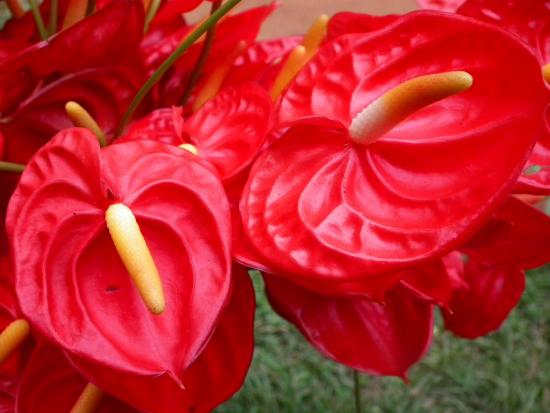
In this case, it is recommended to replant the plant in new soil. If the anthurium does not bloom, this may be due to improper care or the presence of pests. If curling of the leaves is observed, then most likely the container with the plant was in a draft or in direct sunlight. To avoid possible problems when growing anthurium, you should properly and regularly care for the plant.

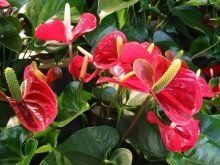

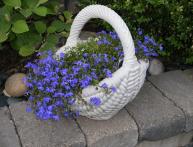

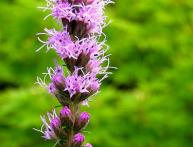
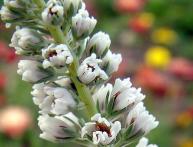
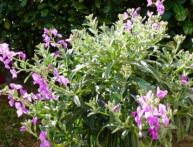

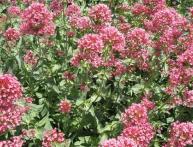
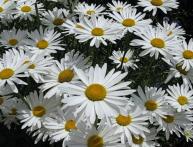
Comments
I have had an anthurium for five years now and the conditions created for it in my apartment seem to suit it. Since it often pleases me with abundant flowering and lush greenery. I have a south-facing window, but the flower is not exposed to the full sun, I water it moderately and spray it often.